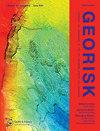Effects of flood wave shape on probabilistic slope stability of dikes under transient groundwater conditions
IF 4.8
3区 工程技术
Q1 ENGINEERING, GEOLOGICAL
Georisk-Assessment and Management of Risk for Engineered Systems and Geohazards
Pub Date : 2023-06-15
DOI:10.1080/17499518.2023.2222540
引用次数: 0
Abstract
ABSTRACT The time-dependent response of pore water pressures during floods largely determines the safety against geotechnical failure of dikes, which is deemed to be highly dependent on the uncertain shape (duration, maximum height, etc.) of the flood discharge wave. This paper derives the uncertainty of flood wave shape from a database of precalculated hydrographs (GRADE) and evaluates the effect of shape variability on probabilistic safety estimates of slope stability, using a modelling chain consisting of a transient hydrological model (MODFLOW) and a probabilistic dike slope safety assessment (FORM). Accounting for flood wave uncertainty with transient groundwater flow generally leads to higher reliability estimates for slope stability, compared to the steady-state groundwater condition and other conservative assumptions, but to lower reliability estimates compared to a single design flood wave. Furthermore, the uncertainty of the flood wave shape can be as important as the uncertainty in geotechnical properties. For landside dike slope stability, the volume of the flood wave is the most important factor, while riverside slope stability depends mainly on the total water level drop after the peak. These two waveform characteristics are thus essential uncertainties to consider in probabilistic assessments of dike safety with transient groundwater conditions.瞬态地下水条件下洪水波形对堤防概率边坡稳定性的影响
本文章由计算机程序翻译,如有差异,请以英文原文为准。
求助全文
约1分钟内获得全文
求助全文
来源期刊
CiteScore
8.70
自引率
10.40%
发文量
31
期刊介绍:
Georisk covers many diversified but interlinked areas of active research and practice, such as geohazards (earthquakes, landslides, avalanches, rockfalls, tsunamis, etc.), safety of engineered systems (dams, buildings, offshore structures, lifelines, etc.), environmental risk, seismic risk, reliability-based design and code calibration, geostatistics, decision analyses, structural reliability, maintenance and life cycle performance, risk and vulnerability, hazard mapping, loss assessment (economic, social, environmental, etc.), GIS databases, remote sensing, and many other related disciplines. The underlying theme is that uncertainties associated with geomaterials (soils, rocks), geologic processes, and possible subsequent treatments, are usually large and complex and these uncertainties play an indispensable role in the risk assessment and management of engineered and natural systems. Significant theoretical and practical challenges remain on quantifying these uncertainties and developing defensible risk management methodologies that are acceptable to decision makers and stakeholders. Many opportunities to leverage on the rapid advancement in Bayesian analysis, machine learning, artificial intelligence, and other data-driven methods also exist, which can greatly enhance our decision-making abilities. The basic goal of this international peer-reviewed journal is to provide a multi-disciplinary scientific forum for cross fertilization of ideas between interested parties working on various aspects of georisk to advance the state-of-the-art and the state-of-the-practice.

 求助内容:
求助内容: 应助结果提醒方式:
应助结果提醒方式:


